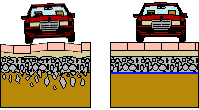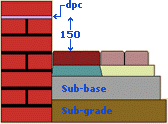There should be 4 layers to all residential flexible block or
brick paving installations, whether on a drive, patio or for
a path. There are complicated assessment methods used
in the paving industry to determine 'ideal' dimensions and
specifications for each application. We find that the following
specification is adequate for 90% of residential applications.
he surface needs to be dug off to a depth of approx. 200mm. average depth of paviors 40mm bedding 100mm sub-base Remove all weeds and other unwanted organic matter.
Excavate any soft spots and fill with compacted sub-base
material. If the area of the paving is troubled with weeds,
you may treat the excavated sub-grade with a general
weedkiller such as Sodium Chlorate, but it is unlikely any
normal weed will be able to penetrate the upper layers.
 |
| If the excavated sub-grade is suspect, clayey, riddled with
Mares Tails or other pernicious, deep-rooted weeds, an
appropriate geo-textile can be laid over the sub-grade.
These geo-textiles can act as root barriers, and help to
keep the overlying sub-base material from sinking into
a clayey or softish sub-grade.
If you require a kerb, this is a good point to construct it.
Road kerbs, plain or decorative edgings, small unit kerbs,
or setts laid lengthways are all suitable. The kerbs must
be laid on and haunched with concrete in order for it to
restrain the body of the paving and prevent it from
disappearing into the garden. If you do not use a concrete bedded kerb unit at the free edges of the pavement, you MUST lay the edging courses on concrete and haunch them as you would a kerb unit. 
|
| Note: Kerbs for flexible block pavements are normally laid on
a concrete bed directly over the sub-grade layer or in a shallow
channel excavated into the sub-base to ensure a full 100mm
depth of bedding material. Bedding the kerbs over the un-altered
sub-base results in too shallow a bed and haunch.
The sub-base is the load-bearing layer of a block or brick pavement
, and should never be omitted. Having said that, existing sub-bases
that are sound and competent can be re-utilised. The sub-base should be a minimum 100mm thick, but can be reduced to 75mm for paths or patios on good ground.
Following completion of the sub-base, the edging courses of the paving
should be constructed before placing the bedding layer and the blocks
/bricks. The perimeter edges of the paving can be laid in a different
colour, or even a different block/brick, which should be laid on a
concrete bed and haunched to prevent lateral (sideways) movement
of the paving. These edges 'frame' the body of the paving and must be
strong enough to withstand the lateral forces generated on a pavement
by traffic.

Note: Edging restraints for flexible block pavements are normally laid
on a concrete bed directly over the sub-grade layer or in a shallow
channel excavated into the sub-base to ensure a full 100mm depth of
bedding material. Bedding the blocks over the un-altered sub-base
results in too shallow a bed and haunch.
There is an exception to the above recommendation, and that is
when an edging course is laid against an existing solid object,
such as a wall, in a position where it can not be overrun by a
vehicle, as shown in the diagram opposite. In a situation such
as this, it is acceptable to lay the soldier edging on a 50mm
concrete bed, solely to ensure that the blocks will not move or
settle when used as a level guide for subsequent screeding of
the bedding layer.
SAND
There seems to be more confusion regarding
| Grading of Fine Aggregate | | Percentage by mass passing B.S sieve | | Sieve Size | Overall
Limits | Additional Limits for Grading | | C | M | F | | 10.00 mm | 100 | - | - | - | | 5.00 mm | 89 -100 | - | - | - | | 2.36 mm | 60 -100 | 60 - 100 | 65 - 100 | 80 -100 | | 1.18 mm | 30 -100 | 30 - 90 | 45 - 100 | 70 -100 | | 600 µm | 15 -100 | 15 - 54 | 25 - 80 | 55 -100 | | 300 µm | 5 -70 | 5 - 40 | 5 - 48 | 5 - 70 | | 150 µm | 0 - 15 | - | - | - | | Sand grading limits - from |
For general on-site construction purposes, there are two main working categories of sand, namely building sand (aka soft sand) which is primarily used in the preparation of mortars, and grit sand (aka sharp sand), which is used as a bedding material for paving. Naturally there are intermediate sands and applications thereof, such as jointing sand, but these are the two most regularly encountered categori
Building sand tends to be a fine sand, often with a clay content of 10% or more while a grit sand will have a low clay content and a greater proportion of larger grain sizes. Finally, two specialist sands; jointing sand, as mentioned above, is used to fill the joints of block paving and is specially selected to have a very low clay content and have grain sizes that will generate a high degree of friction, thereby giving stability and resistance to loading in a block pavement. Page 3 |
|
|
|
|
|
|




No comments:
Post a Comment